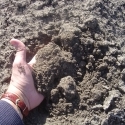Is the cation saturation ratio a good guide to fertilizer use?
 Soil from the Longerenong long term rotation
Soil from the Longerenong long term rotation
The idea that there is a "ideal" soil is somewhat romantic, as a good soil is one that is fit for purpose - which in the case of agriculture is the capacity to sustainably grow plants. To do so the soil should supply the right nutrients, provide storage for water and be aerated so roots and soil microbes can function.
The key point here is that it is amount of nutrients that is critical (sufficiency) rather than some suggested balance of nutrients. The balance is termed is critical - which is the basis - it is not the balance of nutrients that are present. The concept of an ideal balance of nutrients - call the Base Saturation Cation Ratio (BSCR) - has been shown by the science to be fundamentally flawed. Dr Doug Edmeades an independent and respected scientist from New Zealand wrote an excellent analysis of the flaws in the BCSR approach. The whole article can be accessed at right or downloaded below - but in summary the articles shows data that shows:
1. There is no such thing as an ideal ratio of Ca, Mg and K in terms of plant growth or in terms of soil quality.
2. The concepts of soil pH and soil acidity have changed over time. This idea that the best soil pH is 7.0 is no longer tenable.
3. Calculating a Base Saturation percentage using CEC measured at pH 7 grossly underestimates the true proportions of soil nutrients.
4. Basing fertilizer advice on BCSR results in misleading advice,
The science is clear and one of the best reviews of the flaws in the BCSR is given by Kopittke and Menzies (2006) from the University of Queensland - the abstract of this article is given below. Access to the full paper requires a subscription to the Soil Science Society of America Journal.
A Review of the Use of the Basic Cation Saturation Ratio and the “Ideal” Soil
Peter M. Kopittke and Neal W. Menzies
Soil Science Society of America Journal, Vol. 71, 259-265, 2006.
Abstract
The use of “balanced” Ca, Mg, and K ratios, as prescribed by the basic cation saturation ratio (BCSR) concept, is still used by some private soil-testing laboratories for the interpretation of soil analytical data. This review examines the suitability of the BCSR concept as a method for the interpretation of soil analytical data. According to the BCSR concept, maximum plant growth will be achieved only when the soil's exchangeable Ca, Mg, and K concentrations are approximately 65% Ca, 10% Mg, and 5% K (termed the ideal soil). This “ideal soil” was originally proposed by Firman Bear and coworkers in New Jersey during the 1940s as a method of reducing luxury K uptake by alfalfa (Medicago sativa L.). At about the same time, William Albrecht, working in Missouri, concluded through his own investigations that plants require a soil with a high Ca saturation for optimal growth. While it now appears that several of Albrecht's experiments were fundamentally flawed, the BCSR (“balanced soil”) concept has been widely promoted, suggesting that the prescribed cationic ratios provide optimum chemical, physical, and biological soil properties. Our examination of data from numerous studies (particularly those of Albrecht and Bear themselves) would suggest that, within the ranges commonly found in soils, the chemical, physical, and biological fertility of a soil is generally not influenced by the ratios of Ca, Mg, and K. The data do not support the claims of the BCSR, and continued promotion of the BCSR will result in the inefficient use of resources in agriculture and horticulture.
The full article as well as a downloadable version can be accessed at:
https://www.soils.org/publications/sssaj/articles/71/2/259
Additional Resources
Agknowledge Fertilizer Review #26Size: 1.36 MB




